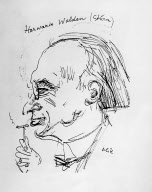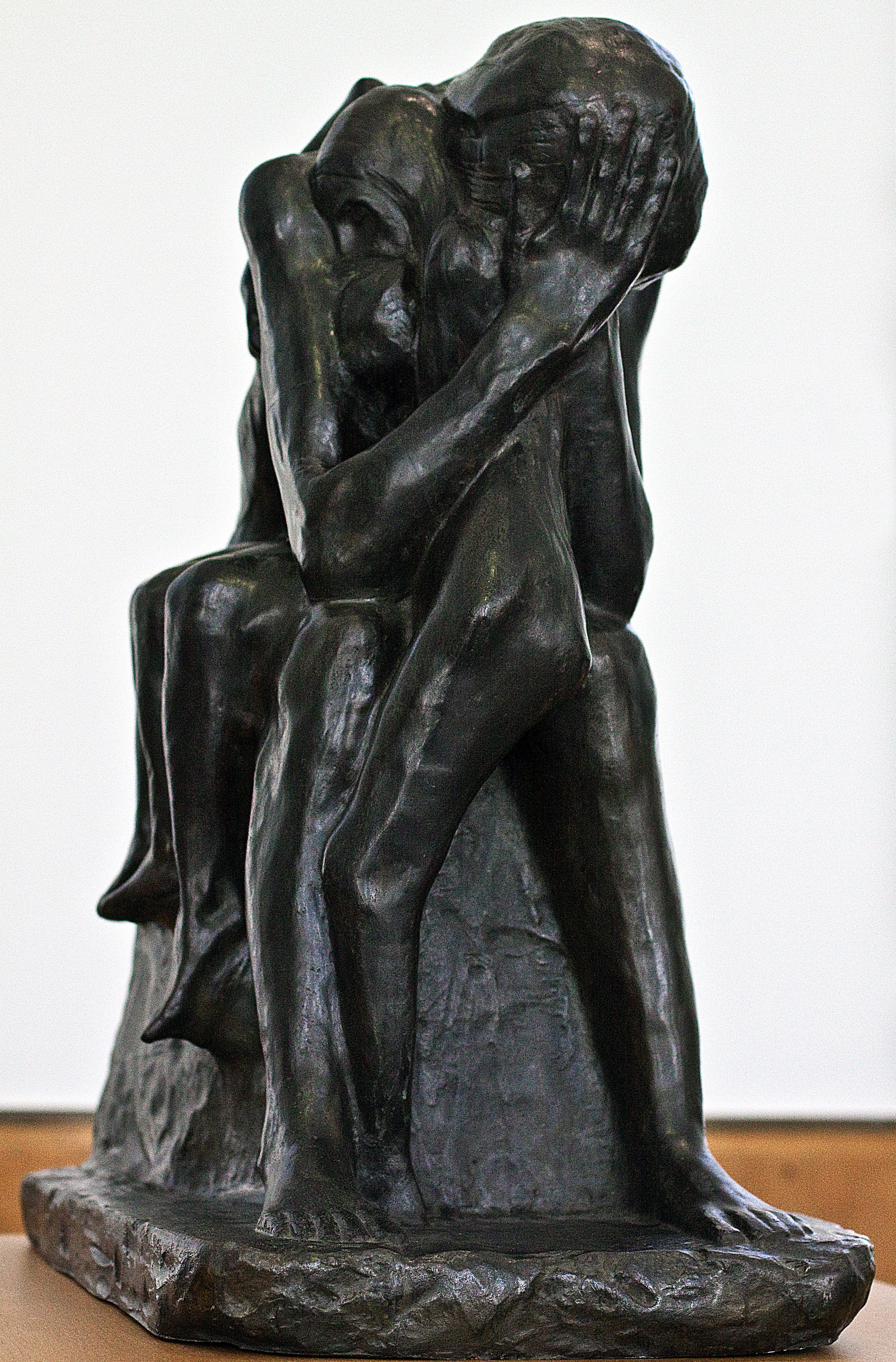|
Oskar Kokoshka
Oskar Kokoschka (1 March 1886 – 22 February 1980) was an Austrian artist, poet, playwright, and teacher best known for his intense expressionistic portraits and landscapes, as well as his theories on vision that influenced the Viennese Expressionist movement. Early life The second child of Gustav Josef Kokoschka, a Bohemian goldsmith, and Maria Romana Kokoschka (née Loidl), Oskar Kokoschka was born in Pöchlarn. He had a sister, Berta, born in 1889; a brother, Bohuslav, born in 1892; and an elder brother who died in infancy. Oskar had a strong belief in omens, spurred by a story of a fire breaking out in Pöchlarn shortly after his mother gave birth to him. The family's life was not easy, largely due to a lack of financial stability of his father. They constantly moved into smaller flats, farther and farther from the thriving centre of the town. Concluding that his father was inadequate, Kokoschka drew closer to his mother; and seeing himself as the head of the household, he ... [...More Info...] [...Related Items...] OR: [Wikipedia] [Google] [Baidu] |
Erling Mandelmann
Erling Mandelmann (18 November 1935 – 14 January 2018) was a Danish photographer. He began his career as a freelance photojournalist in the mid-1960s. Biography Mandelmann worked for 40 years as a freelance photojournalist and portrait photographer for a number of Swiss and European publications, as well as for various international organizations such as the World Health Organization, International Labour Organization, the United Nations, and Amnesty International. He took more than 500 portraits of people, including the 14th Dalai Lama, Noël Coward, Gertrude Fehr, Nina Hagen, Johnny Hallyday, and Prince Hans-Adam of Liechtenstein. His photo-archives have been deposited at the Historical Museum of Lausanne. Mandelmann died on 14 January 2018 at the age of 82. [...More Info...] [...Related Items...] OR: [Wikipedia] [Google] [Baidu] |
Vienna Secession
The Vienna Secession (german: Wiener Secession; also known as ''the Union of Austrian Artists'', or ''Vereinigung Bildender Künstler Österreichs'') is an art movement, closely related to Art Nouveau, that was formed in 1897 by a group of Austrian painters, graphic artists, sculptors and architects, including Josef Hoffman, Koloman Moser, Otto Wagner and Gustav Klimt. They resigned from the Association of Austrian Artists in protest against its support for more traditional artistic styles. Their most influential architectural work was the Secession Building designed by Joseph Maria Olbrich as a venue for expositions of the group. Their official magazine was called '' Ver Sacrum'' (''Sacred Spring'', in Latin), which published highly stylised and influential works of graphic art. In 1905 the group itself split, when some of the most prominent members, including Klimt, Wagner, and Hoffmann, resigned in a dispute over priorities, but it continued to function, and still functions ... [...More Info...] [...Related Items...] OR: [Wikipedia] [Google] [Baidu] |
Erica Tietze-Conrat
Erica Tietze-Conrat (née Erika Conrat, also known as Erica Tietze; born June 20, 1883 – died December 12, 1958) was an Austrian-born American art historian, one of the first women to study art history, a strong supporter of contemporary art in Vienna and an art historian specializing in Renaissance art and the Venetian school drawings. Life Erica Conrat was born June 20, 1883 in Vienna, Austria. She came from a prominent Jewish family in Vienna, which had converted to Protestantism. She was the youngest of three sisters, and the oldest, Ilse Twardowski-Conrat was a sculptor. The father Hugo Conrat (also known as Hugo Cohn) was an avid music lover and friends of Johannes Brahms. Erica was highly musical, played the piano and was among others friends with Alexander von Zemlinsky and Arnold Schoenberg, through which they met Karl Kraus. They also shared a long-standing friendship with Alma Mahler. Erica Conrat studied art history at the University of Vienna from 1902 until 19 ... [...More Info...] [...Related Items...] OR: [Wikipedia] [Google] [Baidu] |
Hans Tietze
Hans Tietze (May 1, 1880 in Prague – April 4, 1954 in New York City) was an Austrian art historian and member of the Vienna School of Art History. Life and work The son of a Jewish lawyer, Tietze grew up in Prague in a German speaking environment. In 1893, his family moved to Vienna, Austria. From 1900 to 1903, he studied archaeology, history and art history under Alois Riegl, Julius von Schlosser and Franz Wickhoff at the University of Vienna. In 1903, he completed his Ph.D. dissertation, supervised by Wickhoff, on the topic of medieval typological representation. In 1905, he wrote his Habilitationsschrift on Annibale Caracci's frescos at the Palazzo Farnese. In 1905, he married fellow art-history student Erika Conrat. For some time, he was Wickhoff's assistant at Vienna's first art historical institute chaired by Josef Strzygowski. He also became an assistant and secretary at the Commission for Monument Preseveration. In 1909, he was appointed lecturer in art history at the ... [...More Info...] [...Related Items...] OR: [Wikipedia] [Google] [Baidu] |
Peter Altenberg
Peter Altenberg (9 March 1859 – 8 January 1919) was a writer and poet from Vienna, Austria. He played a key role in the genesis of early modernism in the city. Biography He was born Richard Engländer on 9 March 1859 in Vienna. The nom de plume, "Altenberg", came from a small town on the Danube river. Allegedly, he chose the "Peter" to honor a young girl whom he remembered as an unrequited love (it had been her nickname). Although he grew up in a middle class Jewish family, Altenberg eventually separated himself from his family of origin by dropping out of both law and medical school, and embracing Bohemianism as a permanent lifestyle choice. He cultivated a feminine appearance and feminine handwriting, wore a cape, sandals and a broad-brimmed hat, and despised 'macho' masculinity. Discovered by Arthur Schnitzler in 1894 and appreciated by Hugo von Hofmannsthal and Karl Kraus, Altenberg was one of the main proponents of Viennese Impressionism. He was a master of short, a ... [...More Info...] [...Related Items...] OR: [Wikipedia] [Google] [Baidu] |
Herwarth Walden
Herwarth Walden (actual name Georg Lewin; 16 September 1879, in Berlin – 31 October 1941, in Saratov, Russia) was a German expressionist artist and art expert in many disciplines. He is broadly acknowledged as one of the most important discoverers and promoters of German avant-garde art in the early twentieth century (Expressionism, Futurism, Dadaism, Magic Realism). He was best known as the founder of the Expressionist magazine ''Der Sturm'' (The Storm) and its offshoots. Biography He studied composition and piano at the music academies of Berlin and Florence. However, his interest embraced all arts. So he became a musician, composer, writer, critic, and gallery owner. He was best known as the founder of the expressionist magazine ''Der Sturm'' (The Storm) and its offshoots. These consisted of a publishing house and journal, founded in 1910, to which he added an art gallery two years later. He discovered, sponsored and promoted many young, still unknown artists of different s ... [...More Info...] [...Related Items...] OR: [Wikipedia] [Google] [Baidu] |
Adolf Loos
Adolf Franz Karl Viktor Maria Loos (; 10 December 1870 – 23 August 1933) was an Austrian and Czechoslovak architect, influential European theorist, and a polemicist of modern architecture. He was an inspiration to modernism and a widely-known critic of the Art Nouveau movement. His controversial views and literary contributions sparked the establishment of the Vienna Secession movement and postmodernism. Loos was born in Brno to a family of sculptors and stonemasons. His almost deaf father, a stonemason, died when he was 9 and played a role in Loos' interest in arts and crafts. Loos later presented with his father's hearing impairment and other health-related issues. His lack of hearing contributed to his solitary personality. Loos had three tumultuous marriages that all ended in divorce and was convicted as a pedophile in 1928. With changing interests, Loos attended multiple colleges also due to his poor academics and his different desires, which proved to be useful by ... [...More Info...] [...Related Items...] OR: [Wikipedia] [Google] [Baidu] |
Gustav Klimt
Gustav Klimt (July 14, 1862 – February 6, 1918) was an Austrian symbolist painter and one of the most prominent members of the Vienna Secession movement. Klimt is noted for his paintings, murals, sketches, and other objets d'art. Klimt's primary subject was the female body, and his works are marked by a frank eroticism. Amongst his figurative works, which include allegories and portraits, he painted landscapes. Among the artists of the Vienna Secession, Klimt was the most influenced by Japanese art and its methods. Early in his career, he was a successful painter of architectural decorations in a conventional manner. As he began to develop a more personal style, his work was the subject of controversy that culminated when the paintings he completed around 1900 for the ceiling of the Great Hall of the University of Vienna were criticized as pornographic. He subsequently accepted no more public commissions, but achieved a new success with the paintings of his "golden phase", ma ... [...More Info...] [...Related Items...] OR: [Wikipedia] [Google] [Baidu] |
George Minne
George (Georges) Minne (born ''Georgius Joannes Leonardus Minne''; 30 August 1866 – 18 February 1941) was a Belgian artist and sculptor famous for his idealized depictions of man's inner spiritual conflicts, including the "Kneeling Youth" sculpture series. A contemporary of Gustav Klimt and Egon Schiele, Minne's work shows many similarities in both form and subject matter to the Viennese Secessionists, the fathers of Art Nouveau. Life He was born in Ghent, Belgium as the son of an architect (Fredericus Augustus Minne). In 1879, Minne studied painting at the Royal Academy of Fine Arts in Ghent, then in the Académie Royale des Beaux-Arts in Brussels from 1885 through 1889. In 1891 he was elected a member of the arts group Les XX.Price, Renée. ''New Worlds: German and Austrian Art 1890-1940'', New York: Neue Galerie, 2001. He had made his first visit to Paris in 1886 where he met the writers Maurice Maeterlinck and Gregore Le Roy, who introduced him to the French Symbol ... [...More Info...] [...Related Items...] OR: [Wikipedia] [Google] [Baidu] |
Jugendstil
''Jugendstil'' ("Youth Style") was an artistic movement, particularly in the decorative arts, that was influential primarily in Germany and elsewhere in Europe to a lesser extent from about 1895 until about 1910. It was the German counterpart of Art Nouveau. The members of the movement were reacting against the historicism and neo-classicism of the official art and architecture academies. It took its name from the art journal '' Jugend'', founded by the German artist Georg Hirth. It was especially active in the graphic arts and interior decoration. Its major centers of activity were Munich and Weimar and the Darmstadt Artists' Colony founded in Darmstadt in 1901. Important figures of the movement included the Swiss graphic artist Hermann Obrist, Otto Eckmann, and the Belgian architect and decorator Henry van de Velde. In its earlier years, the style was influenced by Modern Style (British Art Nouveau style). It was also influenced by Japanese prints. Later, under the Secessio ... [...More Info...] [...Related Items...] OR: [Wikipedia] [Google] [Baidu] |
Wassily Kandinsky
Wassily Wassilyevich Kandinsky (; rus, Василий Васильевич Кандинский, Vasiliy Vasilyevich Kandinskiy, vɐˈsʲilʲɪj vɐˈsʲilʲjɪvʲɪtɕ kɐnʲˈdʲinskʲɪj; – 13 December 1944) was a Russian painter and art theorist. Kandinsky is generally credited as one of the pioneers of abstraction in western art, possibly after Hilma af Klint. Born in Moscow, he spent his childhood in Odessa, where he graduated at Grekov Odessa Art School. He enrolled at the University of Moscow, studying law and economics. Successful in his profession—he was offered a professorship (chair of Roman Law) at the University of Dorpat (today Tartu, Estonia)—Kandinsky began painting studies (life-drawing, sketching and anatomy) at the age of 30. In 1896, Kandinsky settled in Munich, studying first at Anton Ažbe's private school and then at the Academy of Fine Arts. He returned to Moscow in 1914, after the outbreak of World War I. Following the Russian Revolu ... [...More Info...] [...Related Items...] OR: [Wikipedia] [Google] [Baidu] |


_1927_©_Georg_Fayer_(1892–1950)_OeNB_10452443.jpg)





